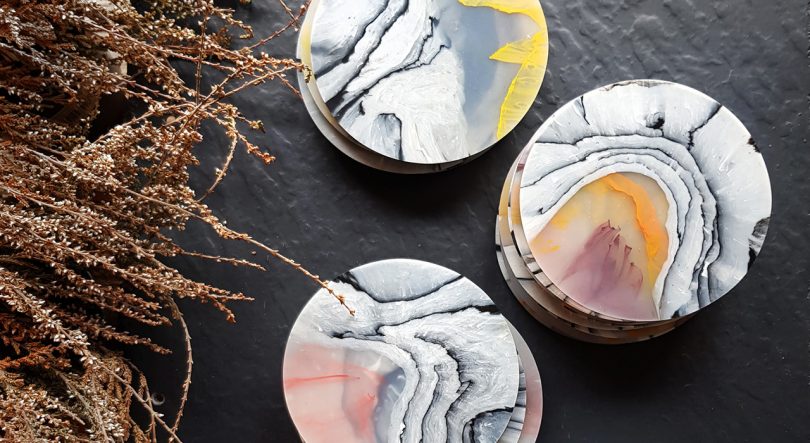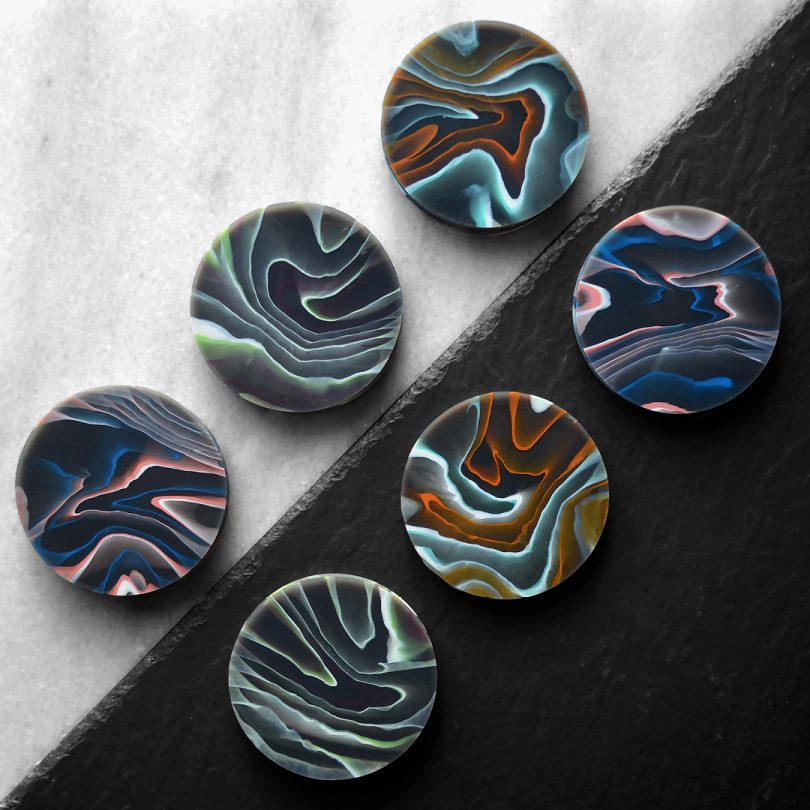UK-based makers Weez & Merl melt and marble plastic waste, such as carrier bags, and turn it into 100% recycled housewares. They operate a free collection scheme for local businesses’ polyethylene waste in their seaside hometowns of Brighton and Hove, on the south coast of the UK, and collaborate with forward-thinking companies on sustainable solutions from bespoke tabletops to specialist surfboard fins. I first spotted their work when I picked up an intriguing coaster in a restaurant and asked the waiter what it was made from, so I had to find out more…
Tell me a little bit about your childhood, education and background in terms of how you first became interested in creativity, design and sustainability.
Our dad is into design, architecture, art and engineering, and our mum is into crafts and painting, so we had a pretty creative and practical upbringing. Moving to England when we were young was a really difficult transition, but growing up having a different cultural background has ultimately been a very good thing. Growing up in Sweden, there’s an intrinsic respect for nature and we did a lot of woodworking, sewing, growing food, gardening and cooking. We’d make things out of what we could find lying around, like a test of your imagination – you can’t beat the satisfaction of making something new from something old. So it makes a lot of sense that we’ve ended up utilizing waste materials in our creative practice!
What are your products made from, how did you select that particular material and how do you source it?
We use LDPE (low-density polyethylene) and MDPE (medium density polyethylene) for different applications – lower density usually for smaller pieces like our coasters, and medium density for larger pieces like tabletops to take advantage of their different properties. Back in 2012, it was clear that plastic bags were being wasted on an epic scale – this was before you had to pay for them in the UK. They were everywhere on the beach, so that’s when I first started collecting and experimenting with them. A few months later when a friend working in a clothes shop told me how much plastic they would throw away with every delivery, I started to understand the scale of the problem, and that the waste was mostly created behind the scenes. I started collecting from that shop on a regular basis after that. We have built on this and now operate a free collection scheme for local businesses’ waste polyethylene here in Brighton & Hove, which saves businesses money and means it actually gets recycled in this country, rather than traveling around the world to be recycled or even landfilled or incinerated.
What inspired this project?
Using unusual materials was always something I was drawn to throughout education, but I became inspired and motivated by Prof. Johnathan Chapman, who had just founded the Sustainable Design MA course at Brighton University at the time. He gave a talk in our first year, and he explained how he had overcome the feeling of the world’s environmental problems being too overwhelming to do anything about, which is a common emotional stumbling block for many designers. I was in the midst of this feeling of hopelessness at the time, but he managed to change my mindset completely to wanting to have an impact, and convincing me that I shouldn’t run away to be a hermit in the woods!
When did you first become interested in using waste as raw material and what motivated this decision?
Waste became a full-on fixation in 2012. I wanted to be a woodworker when I first started my degree, but I wanted to utilize waste materials too, so I often used the offcuts of wood in the scrap bins and the bark from logs. I then was totally sidetracked with creating materials from natural waste, which led to asking cafes to collect eggshells for me, hair from hairdressers, even wet leaves that have to get removed from clogged up drains in the autumn, so I experimented with these materials combined with natural glues, but even though they were very beautiful, they weren’t very useful! After avoiding plastics, I eventually had a go at melting plastic bags that I found on the beach here in Brighton for my very first experiments with polyethylene, and found I actually loved the way they shrunk when you heated them, like shrinking crisp packets when we were little! I saw ‘natural’ qualities in the material that contrasted totally with what I had previously associated it with. The mission from then on was to see what it was capable of, and I started applying traditional craft techniques and tools to it in various ways, from lathing to wattle and daub, straw work like Orkney chair backs, to rammed earth – the latter of which ended up turning into compression molding, which is the main technique we use in our work.
What processes does the material have to undergo to become the finished product?
After collection, we remove contaminants such as paper labels and sticky tape by hand. We then melt it down, using colored plastic bags as our ‘dye’ to create colors, which can be mixed together like paint to create any color you want. Then we use compression molding to press the plastic into molds or sheets of various thicknesses. We can then cut the sheets using bandsaws and table saws into the shape required, and finish the products using sanders or hand planes. Polyethylene is very similar to something like pine in density, and it’s flexible so no danger of shattering, and it cuts and sands beautifully – I realized early that I could apply all my woodworking skills to the material, and this opened up so many doors in the design and craft world.
How did you feel the first time you saw the transformation from waste material to product/prototype?
Complete fascination! It looked so natural, like marble, yet the colors and weight made it obvious it wasn’t. Working with the molten plastic was the first awe-inspiring moment though – it moves so organically, which always surprises people when they see us working with it! It’s like a cross between an extremely hot bread dough and molten sugar – it’s alien but familiar.
There’s so much to explore with this material in terms of colors and marbling styles, so we usually make totally new colorways each time which keeps it really fresh and fun – it means we still get to experience that fascination every time we make something new. It’s important to keep that spark alive! There’s still so much to learn too – there is no rulebook to follow, so we have to figure everything out from scratch. Covid halted our plans to redesign and rebuild our large hydraulic press last year, and so this is the next big project that we can’t wait to get cracking on so that we can finally continue making our larger-scale work and furniture designs.
What happens to your products at the end of their lives? Can they go back into the circular economy?
Polyethylene is not recycled by local councils yet, but all of our products are fully recyclable with us through our return scheme. Recycling is really important but should ideally be the last resort, so we are working on restoration, reparation and exchange schemes too. Hopefully, our customers will want to keep our products for a very long time, but as makers of plastic things, we have a huge responsibility to provide options for them if they don’t. These types of services used to be really common not long ago. The ability to extend the product’s lifespan as long as possible is such an important part of sustainable design, so sometimes it’s worthwhile to revive ideas from the past to help solve current problems.
How have people reacted to this project?
Merl: People’s reactions over the years have always been so encouraging, and sometimes pretty funny. When they pick up one of our coasters for the first time not knowing what it is, their arm flies up in the air as they were expecting it to be heavier like natural stone. They’re usually pretty baffled, then pleasantly surprised to find out it’s made from waste plastic!
Louise: The support from the businesses we collect plastic from has been huge as well – they’re lumped with so much plastic packaging when they receive orders from their suppliers, so they’re happy it’s going to get used and not burned or landfilled.
How do you feel opinions towards waste as a raw material are changing?
I’d say attitudes have changed dramatically over the last eight years since I started regularly working with waste materials – people used to raise an eyebrow at me and not ask questions when I’d ask if they could collect materials for me, but now it seems to be celebrated and starts a conversation every time. Maybe it’s because people are more familiar with environmental issues now, and therefore more willing to engage with solutions. We hope we’ve changed a few people’s opinions as well – that’s definitely our goal anyway. People are becoming more discerning about the products they buy too – the hand-made-to-last, rather than mass-produced-disposable is becoming more desirable again – objects with a story.
What do you think the future holds for waste as a raw material?
Things are looking pretty bright – there are so many inspiring individuals and teams across the world working with new materials crafted from waste. With recycled plastics, it’s a medium just like ceramics, wood or metal – and we see a future full of plastic craftspeople. Already, the “Precious Plastic” project, started by Dave Hakkens, has inspired and mobilized hundreds, if not thousands of people around the world to recycle plastic themselves in their local area, often using homemade machines from the open-source blueprints Hakkens released. Who knows how many people will be crafting recycled plastics in 10 years’ time. Plastics are endlessly recyclable if you treat them with respect by not mixing different types together. And similarly, there seems to be endless ways to use them and work with them – there’s so much left to explore. The great thing is that when we do experiments that don’t work out for whatever reason, we just pop them back in the oven to remelt and try again. There’s no waste this way, all our off-cuts and even our dust from sanding are all captured and remelted.
from WordPress https://connorrenwickblog.wordpress.com/2021/05/11/weez-merl-turn-plastic-carrier-bags-into-housewares-surfboard-fins-more/












No comments:
Post a Comment